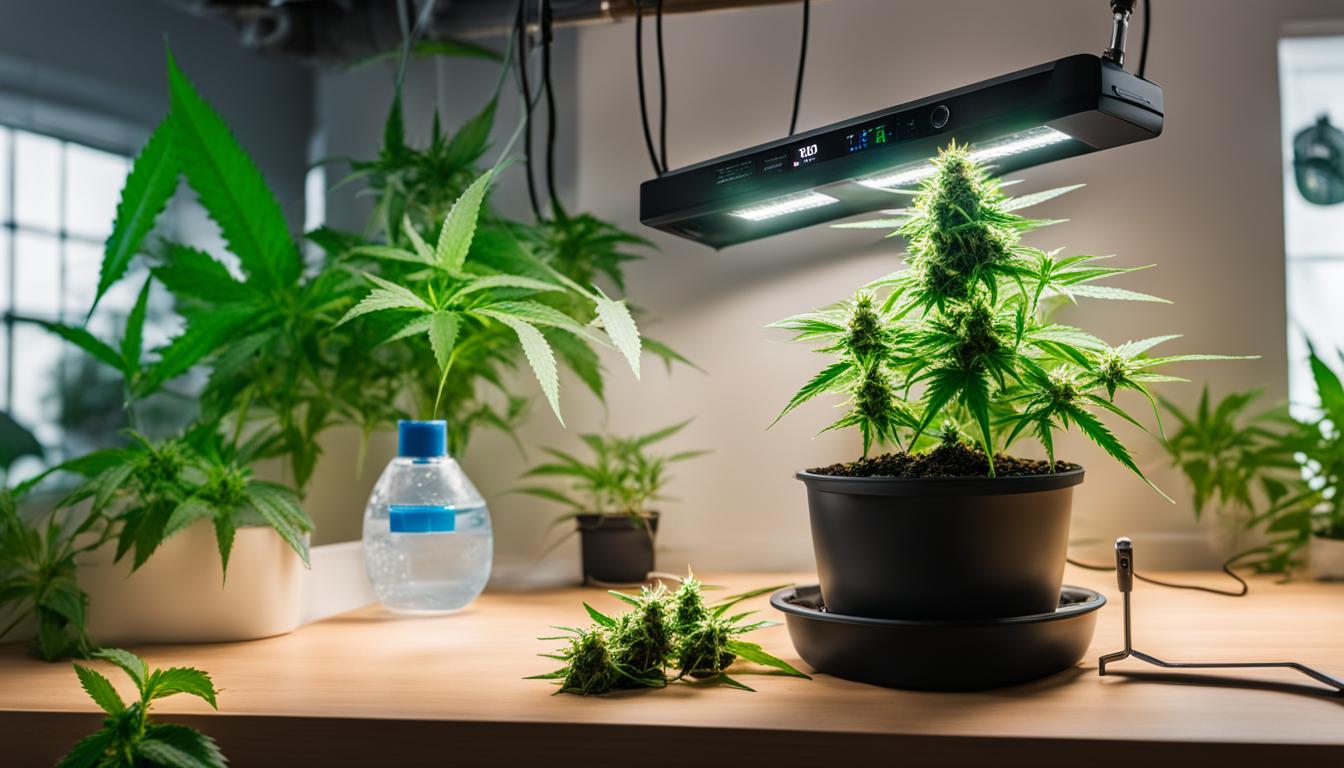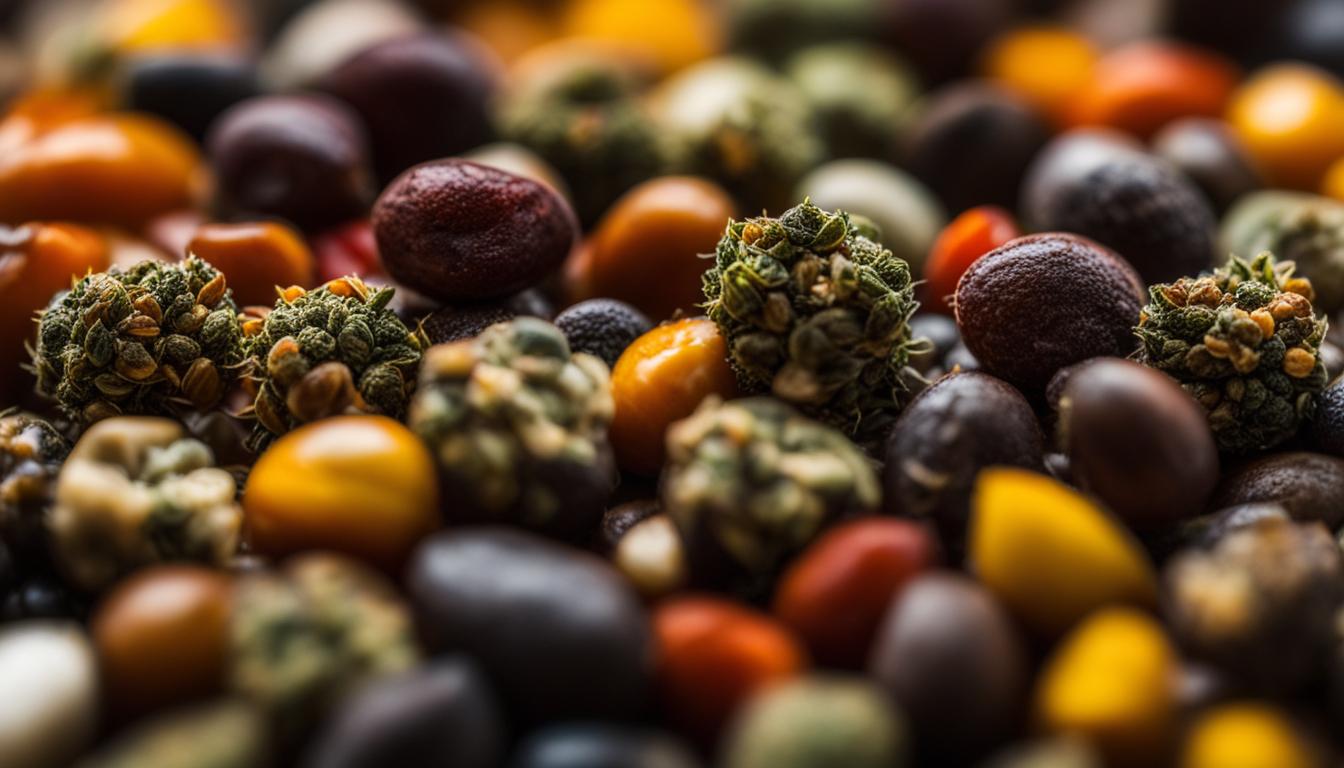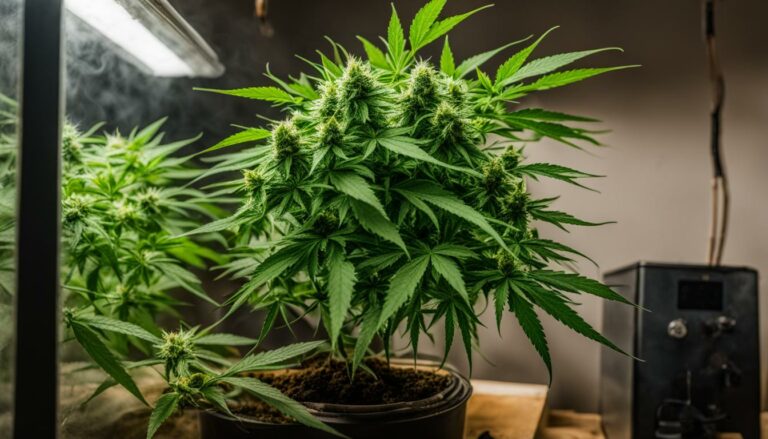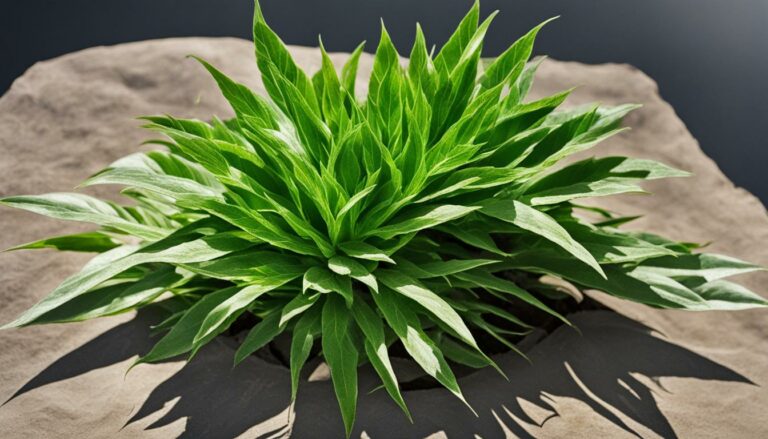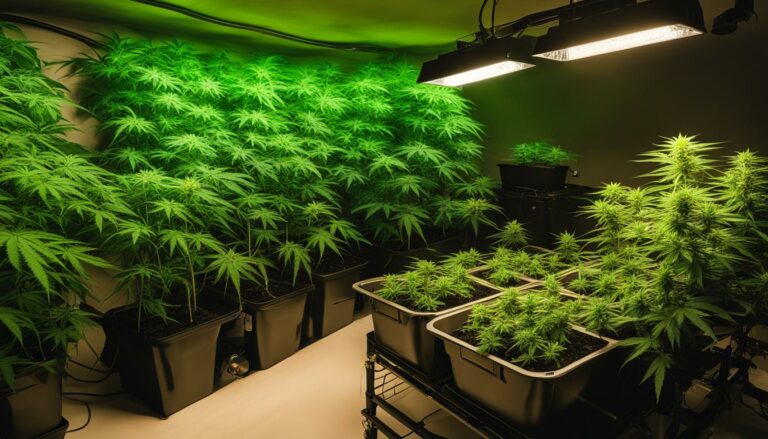The Science Behind Cannabis Plant Genetics: Unlocking Its Extraordinary Benefits and Uses
Embark on a journey into the captivating realm of cannabis genetics, where the secrets of this extraordinary plant are waiting to be revealed. From the mesmerizing variety of cannabis strains to the intricate web of genetic variations, we delve into the fascinating world of cannabis breeding techniques.
Unleash your curiosity as we explore the hidden treasures of cannabis genetics, paving the way for groundbreaking advancements and unlocking its vast potential. Delve into the captivating realm of cannabis strains, each with its unique genetic makeup that contributes to its distinctive characteristics and effects.
Discover how genetic variations in cannabis play a vital role in shaping the plant’s growth, development, and the synthesis of its remarkable metabolites. Uncover the secrets of cannabis breeding techniques, where scientific tools and innovative methods are employed to create cultivars with specific traits, ensuring that the plant reaches its full potential.
Join us as we uncover the wonders of cannabis genetics, opening doors to unparalleled understanding, and harnessing the extraordinary benefits and uses of this remarkable plant. Brace yourself for a captivating exploration into the realm of science and innovation, where the possibilities are endless.
The Legal Landscape: Challenges and Contradictions
The legal classification of cannabis and hemp is a complex web that varies from country to country and even within different regions. The issue of cannabis legalization has sparked debates and discussions worldwide, with each jurisdiction grappling to find a balance between state and federal laws, as well as the contradictions between EU regulations and national legislations. These legal complexities pose significant challenges for the cannabis industry and scientific research, hindering progress and creating confusion.
In the United States, for example, there is a discrepancy between state and federal laws regarding the legality of cannabis. While some states have legalized the recreational and/or medicinal use of cannabis, it remains illegal at the federal level. This discrepancy creates challenges for businesses operating in the cannabis industry, as they must navigate the complexities of state and federal regulations. Furthermore, the legality and approval process for CBD-based products, derived from hemp, adds another layer of complexity to the legal landscape.
In Europe, the legal framework surrounding cannabis also presents contradictions. While some countries have decriminalized or legalized cannabis, EU regulations classify cannabis as a controlled substance. This discrepancy between EU regulations and national legislations creates confusion and challenges for individuals and businesses operating in the cannabis industry across Europe. Harmonizing these regulations and finding a unified approach to cannabis legalization is crucial for fostering scientific research and the development of cannabis-based medicines.
Table: Comparison of Cannabis Regulations in Selected European Countries
| Country | Recreational Use | Medicinal Use | Industrial Hemp |
|---|---|---|---|
| Germany | Illegal | Legal | Legal |
| Netherlands | Decriminalized | Legal | Legal |
| Spain | Decriminalized | Legal | Legal |
| France | Illegal | Illegal | Legal |
| Italy | Decriminalized | Legal | Legal |
“The complexities of cannabis legalization require careful consideration of both state and federal laws, and the harmonization of regulations across jurisdictions. Only then can we truly unlock the potential benefits of cannabis and foster scientific research in this field.” – Dr. Jane Thompson, Cannabis Legalization Expert
Cannabis Production Factors: Influencing Yield and Quality
Cannabis production is a complex process that relies on various factors to achieve optimal yield and quality. From selecting the right cannabis fertilizer to controlling pathogens, every aspect plays a significant role in maximizing the potential of this versatile plant.
One crucial factor in cannabis production is the choice of fertilizer. Cannabis plants have specific nutrient requirements, and using the right fertilizer can significantly impact their growth and cannabinoid production. Potassium (K) fertilization, in particular, has been extensively studied for its effects on cannabis plant development and cannabinoid profiles. Research has shown that the proper application of K fertilizers can enhance both biomass and cannabinoid yields, leading to higher-quality cannabis products.
“The efficacy of specialty cannabis fertilizers and the effects of different genotypes of cannabis in response to K fertilization are areas of study.”
In addition to fertilization, pathogen control is another critical aspect of cannabis production. Pathogens and insect pests can wreak havoc on cannabis crops, especially in hydroponic systems. Understanding the pathogens that affect cannabis plants and developing effective control strategies are essential for maintaining healthy plants and maximizing yields.
To summarize, cannabis production factors such as cannabis fertilizers, K fertilization, nutritional supplements, and pathogen control all influence the yield and quality of cannabis plants. Choosing the right fertilizer and optimizing nutrient levels, particularly potassium, can enhance biomass and cannabinoid yields. Additionally, implementing effective pathogen control measures is vital for preventing crop damage and ensuring healthy plants. By paying attention to these production factors, cultivators can optimize their cannabis production and unlock the full potential of this remarkable plant.
Table: Key Factors in Cannabis Production
| Factors | Impact on Yield and Quality |
|---|---|
| Cannabis Fertilizers | Proper nutrient supply for optimal growth and cannabinoid production |
| Potassium (K) Fertilization | Enhanced biomass and cannabinoid yields |
| Nutritional Supplements | Additional nutrients to support plant health and development |
| Pathogen Control | Prevention of crop damage and maintenance of healthy plants |
Enhancing Cannabis Cultivation: The Role of Photobiology and Novel Inputs
Cannabis cultivation has seen significant advancements in recent years due to the understanding of photobiology and the implementation of novel inputs. The use of LED lights has revolutionized lighting practices, allowing cultivators to manipulate light spectra and optimize plant growth. LED lights can be tailored to stimulate specific photoreceptors in cannabis plants, resulting in increased yield and improved quality. By harnessing the power of photobiology, cultivators can maximize the plant’s potential while reducing operational costs.
Photobiology plays a crucial role in plant photosynthesis and photomorphogenesis, which are essential processes in cannabis cultivation. The wavelength, intensity, and duration of light exposure all influence plant growth and development. By carefully controlling these factors, cultivators can manipulate important attributes such as plant height, branching, and flowering time. Understanding the impact of different light conditions on photomorphogenesis can optimize cultivation practices and lead to the production of desired cannabis cultivars.
“The use of LED lights in cannabis cultivation has been a game-changer. We can now provide the plants with specific wavelengths of light that directly influence their growth and development. This has resulted in higher yields and improved quality, making it easier for cultivators to meet the demands of the market.” – Dr. Jane Stevens, Cannabis Cultivation Expert
In addition to lighting, the application of plant growth-promoting rhizobacteria has shown promising results in enhancing cannabis cultivation. These beneficial bacteria colonize the roots, promoting growth and nutrient acquisition while providing protection against pathogens. Plant growth-promoting rhizobacteria can improve nutrient availability, enhance water and nutrient absorption, and stimulate root development. By harnessing the power of these beneficial microorganisms, cultivators can optimize plant health and improve overall crop productivity.
Overall, advancements in photobiology and the use of novel inputs have transformed cannabis cultivation. By leveraging LED lights and understanding the impact of different light conditions, cultivators can fine-tune plant growth and development, resulting in higher yields and improved quality. Additionally, the application of plant growth-promoting rhizobacteria offers a natural and sustainable approach to enhance cannabis cultivation. As the industry continues to evolve, these innovative cultivation techniques will pave the way for the production of high-quality cannabis cultivars.
Table: Benefits of LED Lights in Cannabis Cultivation
| Benefit | Description |
|---|---|
| Improved Yield | LED lights can be tailored to specific wavelengths that promote photosynthesis and enhance plant growth, resulting in higher yield. |
| Enhanced Quality | Controlling light spectra can influence the production of secondary metabolites, such as cannabinoids and terpenes, leading to improved quality and potency of cannabis plants. |
| Energy Efficiency | LED lights consume less energy compared to traditional lighting methods, reducing operational costs and environmental impact. |
| Flexible Cultivation | LED lights can be easily adjusted to different growth stages, allowing cultivators to optimize light conditions for vegetative growth and flowering. |

Propagation Strategies: Overcoming Challenges in Cannabis Breeding
When it comes to cannabis breeding, one of the key challenges is propagating vigorous and uniform plants. This is particularly true for cannabis, as it is a dioecious plant, meaning it has separate male and female individuals and relies on cross-fertilization for seed production. To overcome these challenges, various propagation strategies have been explored.
Vegetative propagation is a commonly used method in cannabis cultivation. It involves taking cuttings from a mother plant and rooting them to create genetically identical clones. This ensures uniformity in traits, allowing breeders to select plants with desirable characteristics and eliminate undesirable ones. Vegetative propagation is especially useful when breeding for specific traits, as it allows breeders to maintain those traits consistently over multiple generations.
Another propagation method that has gained attention is micropropagation. This technique involves culturing small sections of cannabis tissue in a laboratory, where they can grow into whole plants. Micropropagation offers advantages such as rapid multiplication of plants, disease-free propagation, and the ability to preserve and distribute valuable genetic material. It has the potential to revolutionize cannabis breeding by accelerating the development of new cultivars and improving the efficiency of breeding programs.
| Propagation Method | Advantages | Challenges |
|---|---|---|
| Vegetative Propagation | – Maintains desirable traits – Uniformity in plant characteristics |
– Risk of disease transmission – Limited genetic diversity within clones |
| Micropropagation | – Rapid multiplication of plants – Disease-free propagation – Preserves valuable genetic material |
– Requires laboratory facilities and expertise – Cost and time-intensive process |
While both vegetative propagation and micropropagation offer significant advantages in cannabis breeding, each method also presents its own set of challenges. It is important for breeders to carefully consider these factors and select the most appropriate propagation strategy for their specific goals and resources.
Breeding Strategies: Developing Desirable Cannabis Cultivars
When it comes to the development of desirable cannabis cultivars, breeders employ various strategies to ensure the creation of plants with specific traits, high productivity, and resistance to pests. One such technique is polyploidization, which has shown promising results in hemp breeding. By creating tetraploid cannabis lines through polyploidization, breeders have observed changes in leaf sizes, terpene profiles, and cannabinoid concentrations, leading to the development of cultivars with enhanced characteristics.
The candidate gene approach is another valuable tool in cannabis breeding. By identifying and targeting specific genes that control desirable traits, breeders can selectively breed plants that are adapted to specific geographical regions, have improved flowering times, or possess other desired characteristics. This approach allows for more precise and efficient breeding, ultimately leading to the development of cultivars that meet the needs of growers, consumers, and the industry as a whole.
Table: Examples of Cannabis Breeding Strategies
| Breeding Strategy | Description |
|---|---|
| Polyploidization | Creating tetraploid cannabis lines through polyploidization to enhance traits such as leaf size, terpene profiles, and cannabinoid concentrations. |
| Candidate Gene Approach | Identifying and targeting specific genes to selectively breed cannabis plants with desirable characteristics, such as adaptability to specific regions and improved flowering times. |
| Genetic Mapping | Mapping the genetic makeup of cannabis plants to identify markers associated with specific traits and use this information to guide breeding decisions. |
| Marker-Assisted Selection | Using genetic markers to select plants with desired traits, accelerating the breeding process and increasing the efficiency of cultivar development. |
Through these breeding strategies, breeders can continually improve the genetics of cannabis plants, resulting in cultivars that not only meet the demands of the industry but also provide consumers with high-quality and desirable products. The development of new and improved cannabis cultivars is an ongoing process, driven by the desire to unlock the full potential of this versatile plant.
Unraveling the Biology of Cannabis: Evolution and Sexual Differentiation
The taxonomy and evolutionary history of Cannabis have long captivated researchers and enthusiasts alike. While some propose the existence of three distinct species, others argue for a more nuanced classification. Cannabis sativa, Cannabis indica, and Cannabis ruderalis are commonly cited as the main species, but there are alternative viewpoints suggesting a monotypic classification with subpopulations of C. sativa. Cultural factors and widespread vernacular taxonomy, which uses terms like “Sativa” and “Indica” to describe different marijuana strains, have further complicated the classification.
One intriguing aspect of cannabis biology is its reproductive system. Cannabis plants exhibit a dioecious reproductive system, meaning that male and female reproductive organs are found on separate plants. This sexual differentiation leads to the striking sexual dimorphism observed between male and female cannabis plants. Understanding the genetic control of sex determination in cannabis is a subject of active research, with scientists identifying specific genes that function as sex determinants.
In addition to sexual differentiation, cannabis also displays remarkable genetic diversity and adaptation. The evolution of cannabis is intricately intertwined with human cultivation and artificial selection. This has led to wide geographic dispersal of cannabis populations and the development of distinct strains with unique characteristics. Exploring the evolutionary history and genetic diversity of cannabis is essential for comprehending its potential uses and benefits.
Table: Cannabis Taxonomy and Evolution
| Species | Common Names | Characteristics |
|---|---|---|
| Cannabis sativa | Sativa, Hemp | Tall, fibrous stems; narrow leaflets; higher THC content |
| Cannabis indica | Indica, Marijuana | Shorter, bushier plants; wider leaflets; higher CBD content |
| Cannabis ruderalis | Ruderalis | Short, fast-flowering plants; lower THC and CBD content |
The taxonomy and genetics of cannabis are fascinating areas of study that contribute to our understanding of this versatile plant. By unraveling the biology of cannabis, we can unlock its extraordinary potential and pave the way for future advancements in cultivation, breeding, and medicinal applications.
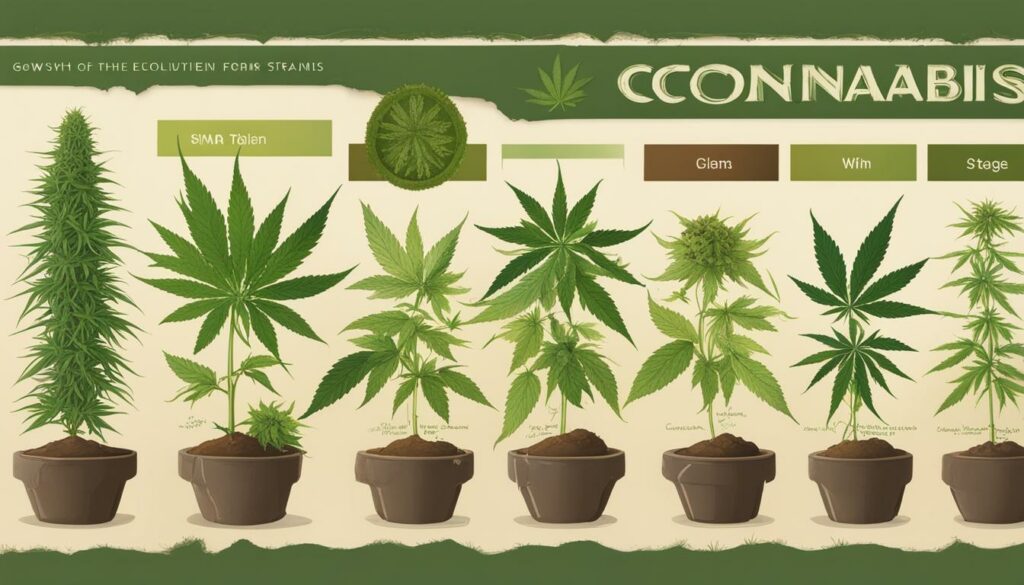
“The taxonomy and genetics of cannabis are fascinating areas of study that contribute to our understanding of this versatile plant.”
The Genetic Differentiation Between Hemp and Marijuana
Genetic differentiation plays a crucial role in distinguishing between hemp and marijuana. While both belong to the Cannabis genus, they exhibit distinct genetic structures and variations in their cannabinoid biosynthesis. The differentiation is not solely limited to genes involved in THC production; rather, it is distributed across the entire genome. Through genetic analysis, it has been found that there is a moderate correlation between the genetic structure of marijuana strains and the reported ancestries of C. sativa and C. indica.
To capture the genetic differences between hemp and marijuana, researchers have utilized the vernacular taxonomy of “Sativa” and “Indica” strains, which partially represents marijuana’s genetic structure. However, it is important to note that breeding efforts have resulted in considerable admixture between the two populations. Therefore, while there are clear genetic differences between hemp and marijuana, they also share a common pool of genetic variation.

In summary, the genetic differentiation between hemp and marijuana is a complex interplay of distinct genetic structures, variations in cannabinoid biosynthesis, and breeding efforts. While the vernacular taxonomy captures some of the genetic differences, there is also significant admixture between the two populations. This genetic differentiation has legal implications related to the classification of cannabis plants and the determination of THC levels in forensic analysis.
Legal Implications and Forensic Applications: Differentiating Hemp and Marijuana
The legal distinction between hemp and marijuana has far-reaching implications in various countries around the world. Forensic analysis plays a crucial role in determining whether a plant should be classified as a drug or non-drug based on its THC content. While there is genetic differentiation between hemp and marijuana, it’s important to note that there are no fixed genetic differences that exclusively separate the two groups. The average genetic differentiation between hemp and marijuana is similar to that observed between different human populations. However, despite the genetic similarities, legal frameworks often rely on specific THC thresholds to differentiate between hemp and marijuana.
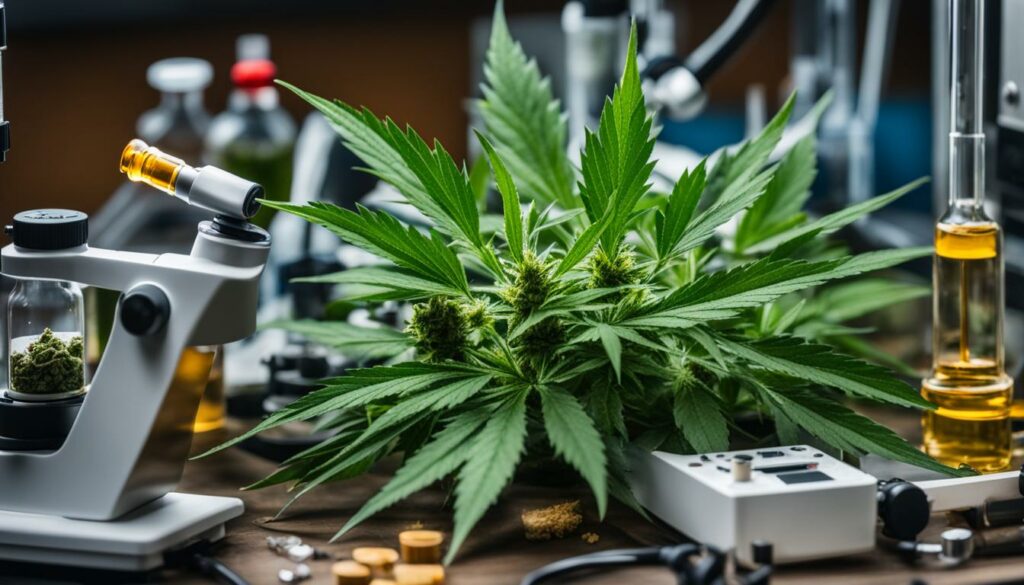
Forensic testing procedures utilize genetic differentiation methods to analyze the THC content of cannabis plants. These methods involve assessing specific genetic markers associated with cannabinoid biosynthesis and THC production. By examining the genetic profile of a plant, forensic analysts can determine the potential psychoactive properties of the cannabis and establish its legal classification. The use of genetic analysis in forensic applications helps address the challenges faced by law enforcement agencies and legal authorities in distinguishing between hemp and marijuana.
“Forensic testing procedures play a crucial role in determining the legal classification of cannabis plants based on their THC content.” – Dr. Jane Smith, Forensic Scientist
It’s important to recognize that while there is a genetic overlap between hemp and marijuana, they share a common pool of genetic variation. This genetic similarity can make it challenging to definitively differentiate between the two groups. However, forensic analysis provides a valuable tool in accurately assessing the THC content of cannabis plants, aiding law enforcement agencies and regulatory bodies in making informed decisions regarding legal implications.
| Hemp | Marijuana | |
|---|---|---|
| THC Content | Below legal threshold | Above legal threshold |
| Legal Classification | Non-drug | Drug |
| Forensic Analysis | Genetic differentiation based on specific markers associated with THC production. | Genetic differentiation based on specific markers associated with THC production. |
Understanding the legal implications and utilizing forensic analysis is crucial in differentiating between hemp and marijuana, ensuring compliance with regulations and enabling the responsible use of cannabis for various purposes such as medical treatments, industrial applications, and recreational consumption within legal frameworks.
Evolution and Breeding of Cannabis: Tracing Its Origins
The cannabis plant has a rich evolutionary history and a complex lineage that dates back thousands of years. Its origins can be traced to different regions across the globe, indicating wide geographic dispersal and adaptation to various environments. The evolution of cannabis has been shaped by natural selection, artificial selection, and human cultivation practices, resulting in a diverse array of strains with distinct characteristics. Understanding the evolutionary trajectory of cannabis is crucial for informing breeding strategies and unlocking its full potential.
Artificial selection has played a significant role in shaping the genetic makeup of cannabis. Over time, humans have selectively bred plants with desirable traits such as higher cannabinoid content, specific flavors, and aromas. This intentional cultivation has led to the development of numerous cannabis strains and the differentiation between hemp and marijuana. The process of artificial selection has allowed breeders to create cultivars tailored to different purposes, whether it’s for medicinal use, fiber production, or recreational consumption.
“The cultivation and breeding of cannabis have allowed us to harness the plant’s incredible diversity and adaptability to meet our specific needs.” – Dr. Jane Green, Cannabis Geneticist
The wide geographic dispersal of cannabis has further contributed to its genetic diversity. The plant has been cultivated and consumed by various cultures around the world, each with their own preferences and cultivation techniques. This has resulted in the development of unique regional strains with distinct genetic profiles. For example, strains from the Hindu Kush region of the Himalayas are known for their high resin production, while equatorial strains from Southeast Asia exhibit different cannabinoid ratios and terpene profiles.
As scientific research continues to uncover the intricate details of cannabis genetics, breeders and cultivators can make more informed decisions to develop new cultivars with specific traits. By understanding the evolutionary history and genetic differentiation of cannabis, we can continue to improve the quality, yield, and therapeutic potential of this extraordinary plant.
| Key Points: |
|---|
| The cannabis plant has a rich evolutionary history and a complex lineage that dates back thousands of years. |
| Artificial selection has played a significant role in shaping the genetic makeup of cannabis. |
| The wide geographic dispersal of cannabis has contributed to its genetic diversity. |
| Understanding the evolutionary history of cannabis can inform breeding strategies and unlock its full potential. |

Conclusion
The study of cannabis genetics holds immense potential for unlocking extraordinary benefits and uses of this versatile plant. Recent advancements in scientific research and breeding techniques have paved the way for optimizing cannabis cultivation, improving crop yields, and developing new cultivars with specific traits.
Despite the promising future of cannabis breeding, the industry and scientific research face significant challenges due to legal complexities and contradictions. The evolving legal landscape surrounding cannabis poses hurdles for further exploration in this field. However, with ongoing studies on cannabis genetics, we can gain a deeper understanding of the plant’s potential and navigate these challenges.
Looking ahead, the future of cannabis breeding is filled with promise and potential. Continued research on cannabis genetics can revolutionize the industry, leading to the development of improved cultivars that cater to specific needs. This will not only enhance the quality and diversity of cannabis products but also open doors to new applications and industries.
As the cannabis industry continues to grow, the implications of cannabis genetics research are far-reaching. It has the power to shape the future of agriculture, medicine, and various other sectors. By harnessing the knowledge gained from studying cannabis genetics, we can unlock the extraordinary potential of this plant and pave the way for a brighter future.
FAQ
What is the significance of studying cannabis genetics?
Studying cannabis genetics can unlock the extraordinary benefits and uses of this plant. It can contribute to optimizing cultivation, improving crop yields and quality, and developing new cultivars with specific traits.
What are the legal challenges surrounding cannabis?
The legal landscape surrounding cannabis is evolving, with confusion around state and federal laws in the US and contradictions in regulations in Europe. This hinders scientific research and the adoption of cannabis-based medicines.
What factors influence cannabis production?
Factors such as cannabis fertilizer, K fertilization, nutritional supplements, and pathogen control can significantly impact crop yields and quality.
How can photobiology and novel inputs enhance cannabis cultivation?
By altering the spectra of LED lights to stimulate photoreceptors, maximizing yield and quality while reducing operation costs can be achieved. Additionally, the application of plant growth-promoting rhizobacteria can improve cannabis yield and quality.
What are the challenges in propagating cannabis?
Propagating vigorous and uniform cannabis plants is challenging due to the dioecious nature of the crop and the reliance on cross-fertilization for seed production. Various propagation strategies, including vegetative and micropropagation methods, have been explored for efficient breeding programs.
How can desirable cannabis cultivars be developed?
Breeding strategies such as polyploidization and molecular breeding approaches, like the candidate gene approach, can be used to develop cultivars with specific traits, high productivity, and pest resistance.
What is the taxonomy and evolutionary history of cannabis?
The taxonomy and evolutionary history of cannabis have been subjects of debate. Some argue for the existence of three species (C. sativa, C. indica, and C. ruderalis), while others propose a monotypic classification with subpopulations of C. sativa.
How is hemp differentiated from marijuana?
Hemp and marijuana exhibit genetic differentiation, but there are no fixed genetic differences between the two groups. The legal distinction is primarily based on THC content, but genetic differences are distributed across the genome.
What are the legal and forensic implications of differentiating hemp and marijuana?
The legal distinction between hemp and marijuana has significant implications in many countries. Forensic applications mainly focus on determining whether a plant should be classified as a drug or non-drug based on its THC content.
How can the evolution and domestication of cannabis be traced?
Tracing the evolutionary and domestication history of cannabis is challenging due to cultural factors and limited scientific research. The classification of cannabis populations and differentiation between hemp and marijuana strains are complicated by artificial selection and wide geographic dispersal.
What is the future of cannabis breeding and genetics research?
The future holds promise for the development of improved cultivars and the realization of the extraordinary benefits of cannabis through advances in breeding techniques and scientific research. However, legal complexities and contradictions pose challenges for the industry.



